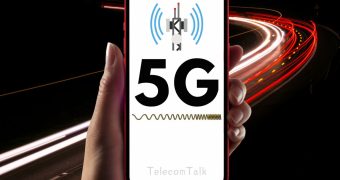
Ericsson has recently announced advancements in 5G infrastructure across key global markets, reflecting the company's strategic focus on accelerating connectivity. From Germany's gigabit-speed train connectivity trials to Jordan's cloud-native BSS transformation, these developments reflect the accelerating pace of 5G adoption and innovation.
Also Read: Ericsson: Optus 5G Antennas, Cloud-Native Core with Google Cloud, Sweden AI Factory and More
1. Germany Launches GINT XT to Test Shared 5G Infrastructure for Gigabit-Speed Internet on Trains
Germany has launched GINT XT (Gigabit Innovation Track XT), its first nationwide project to test shared 5G infrastructure aimed at delivering gigabit-speed internet on trains. In a collaboration, Deutsche Bahn has joined forces with all four national mobile network operators—1&1, Deutsche Telekom, O2 Telefonica, and Vodafone—alongside technology and infrastructure partners to address connectivity challenges in rail travel.
The initiative is being piloted on a 12-kilometre route in Mecklenburg–Western Pomerania, where advanced 5G network components such as antennas, software, and base stations are being trialled under real-world rail conditions. Key project partners include Vantage Towers (radio mast operator), Ericsson (5G network technology provider), the German Aerospace Center (DLR), and Regio Infra Nord-Ost (RIN). The project is funded by the Federal Ministry for Digitalisation and Government Modernisation (BMDS).
Ericsson, in a statement on June 12, 2025, said that GINT XT builds on the success of the previous GINT project to make uninterrupted gigabit-capable connectivity a reality for rail passengers. For the first time, all four mobile operators are actively sharing network infrastructure to provide continuous high-speed coverage along the route. The Ericsson 5G core network, developed at the company's R&D center in Aachen, serves as the technical backbone of the trial.
In addition to improving passenger experience, the project will explore integration with the upcoming Future Railway Mobile Communication System (FRMCS)—a modern telecom standard intended to replace the current 2G-based GSM-R system by 2035. The modular, dual-use masts being deployed are designed to support both railway operations and public mobile networks, allowing for quicker and more cost-effective rollouts.
"Results from the GINT XT test track will help to decide upon the eventual use of FRMCS infrastructure for mobile communication services along the Hamburg–Berlin rail corridor, a designated innovation route for high-speed rail connectivity. A declaration of intent signed in October 2024 between DB, the mobile providers, and the federal government sets the path for a scalable and tech-neutral approach to "5G on the Track," Ericsson said.
Karsten Wildberger, Federal Minister for Digital and Government Modernisation (BMDS) of Germany says: "High-speed Internet on trains must not remain a dream of the future. For a modern country, it must be a matter of course that people can also use the internet on trains to work, stream and make phone calls without any limitations. For this to succeed, complex technical challenges must be overcome. With the 'Gigabit Innovation Track XT' project, the Ministry of Transport and the companies involved are doing real pioneering work and showing what can be achieved when joining forces. This is also the most important signal for our mission."
Daniela Gerd tom Markotten, Board Member for Digitalisation and Technology at Deutsche Bahn AG: "Last year, the GINT partners set up a test track with mobile phone masts close to the rails in record time. Now, for the first time, all German public mobile communications companies are investigating how gigabit coverage can be achieved along this test track. Because that's what people want: working, participating in video conferences or making phone calls while travelling by train. We will work together to fulfil this demand!"
Daniel Leimbach, Managing Director of Ericsson GmbH, added: "For the first time, the GINT XT project enables the active sharing of radio network resources between all four mobile network operators in Germany. Ericsson is providing the technology foundation for this - including a preconfigured 5G core network infrastructure from our Ericsson R&D Center Eurolab in Aachen, Germany."
GINT XT is a significant milestone in Germany's efforts to modernise its digital infrastructure and is likely to set a precedent for shared mobile networks in high-speed rail systems across Europe.
2. Orange Maroc and Ericsson Partner to Modernise Core Network Ahead of 5G Launch
Orange Maroc has signed an agreement with Ericsson to modernise and expand its core network, marking a step forward in strengthening the operator’s infrastructure ahead of Morocco's 5G rollout. The partnership supports the objectives of the national "Digital Morocco 2030" strategy and underscores Orange Maroc’s commitment to delivering high-performance connectivity.
Under the agreement, Orange Maroc will integrate Ericsson’s dual-mode 5G Core and Cloud Native Infrastructure Solution, designed to support cloud-native 5G applications. "This modernization will significantly boost Orange Maroc's network capacity and enhance the customer experience, while allowing the company to build a scalable network architecture in anticipation of the 5G introduction," Ericsson said on June 9, 2025.
As part of the modernisation, Orange Maroc will deploy the Ericsson Cloud Core Policy Controller, enabling high scalability, enhanced resilience, and the flexibility to support new digital business models. The telecom operator will also extend its network with additional IP Multimedia Subsystem (IMS) and Ericsson Packet Core sites to strengthen Voice over LTE (VoLTE) services and deliver 4G and 5G services, such as the enhanced Mobile Broadband (eMBB), Fixed Wireless Access (FWA), video games, and industrial connectivity services.
The project also entails automation and orchestration enhancements across Orange Maroc's cloud-native infrastructure. This includes upgrades to Ericsson Network Manager, Orchestrator, and Network IQ Statistics, software solutions already in use to optimise and monitor network performance.
3. Rogers Begins Deployment of Ericsson 5G Advanced RedCap Technology for IoT
Rogers Communications announced it has started to deploy Ericsson 5G Advanced technology on its national network, a first for a Canadian operator, to enhance performance and capabilities for consumers and businesses. Rogers is rolling out Ericsson's 5G Advanced RedCap software to power next-generation IoT.
"With RedCap, IoT devices, such as sensors, cameras and monitoring equipment, use network resources more efficiently and connect seamlessly. For consumers, the technology supports longer battery life for wearables, including smartwatches," Ericsson said in a joint statement on June 4, 2025.
"5G Advanced will help unlock the full potential of 5G for businesses and consumers," said Mark Kennedy, Chief Technology Officer, Rogers. "We continue to invest in Canada's largest 5G network and are proud to be the first in Canada to bring 5G Advanced technology to our customers."
The deployment of Ericsson 5G Advanced features marks another exciting chapter in our collaboration, said Jeanette Irekvist, President, Ericsson Canada.
4. JT Activates First Sites on Ericsson-Powered 5G Standalone Network in Channel Islands
JT has entered the final phase of its multi-million-pound investment in the 5G mobile network with the activation of the first live sites, marking it as a first in the Channel Islands. Powered by Ericsson's 5G Standalone (SA) technology, this comes two years after the partnership, and the new network positions Jersey as one of Europe's earliest adopters.
Ericsson said that after months of trials and painstaking optimisation testing, the operator successfully migrated the old network on sites within Area One in St Ouen and transitioned to the newly built network. Initial performance testing indicates significant improvements in signal strength, coverage, and average download speeds compared to JT's previous mobile network.
The launch event, held at JT's Network Operations Centre, highlighted the collaborative effort between local engineers and global partners. It marks the start of a phased island-wide deployment, with full network completion anticipated by the end of 2025.
"This process of rolling out the new network will take place over several months, with Areas going live in a phased approach. The full 5G Standalone (SA) experience will only be available once all phases are completed, which is expected by the end of 2025," Ericsson said in a joint statement on May 27, 2025.
JT's 5G SA network offers capabilities beyond the widely used 5G Non-Standalone (NSA) systems. The deployment makes JT one of the 60 operators globally with 5G SA technology, joining Ericsson's footprint of 183 active 5G networks in 77 countries.
"JT will be joining 60 leading operators globally with the launch of 5G SA. Combined with JT's full fibre-to-home service, this will provide Islanders with seamless connectivity both on the ground and in the air, making Jersey one of the most connected places in the world and one of the few networks globally to have end-to-end Ericsson technology," Ericsson explained.
JT has also invested in core network upgrades in Guernsey, with plans to expand the 5G rollout once the regulatory framework for spectrum licensing is established there.
5. Ericsson and Zain Jordan Launch Cloud-Native BSS Transformation to Boost Digital Services and 5G Agility
Ericsson and Zain Jordan have launched a Business Support Systems (BSS) transformation project aimed at modernising the operator's digital infrastructure, improving customer experiences, and enhancing operational agility.
The project will upgrade Zain Jordan's converged BSS architecture to a cloud-native model using the Ericsson Cloud Native Infrastructure Solution. A key component of the initiative includes the latest version of Ericsson Charging, integrating new features and capabilities that will allow Zain Jordan to adopt a catalog-based business model. This will enable more personalised and seamless services for prepaid customers.
"This investment reflects our commitment to delivering innovative services and an exceptional customer journey," said Wesam Abu Hashhash, Technology and Digital Innovation Director at Zain Jordan. "By digitalising our prepaid customer service experience with Ericsson's monetisation and core commerce portfolio, we are setting the stage for a more agile and customer-centric approach."
The transformation will allow Zain Jordan to improve time to market, optimise operational costs, increase service agility, and unlock 5G monetisation opportunities.
6. Ericsson Showcases 5G Innovations at Egypt Forum
Ericsson showcased its latest technological innovations and explored opportunities to strengthen collaboration across the Information and Communications Technology (ICT) ecosystem at the Egypt (5G) Forum, organised by Moharram and Partners, held in Cairo on the 19th of May 2025.
Held in collaboration with the Embassies of Finland, Japan, Sweden, and the United States, as well as the European Union Delegation to Egypt, the forum aimed to build consensus on accelerating 5G deployment and regional connectivity initiatives.
According to the official release from Ericsson on May 19, 2025, the gathering was attended by top-level executives from the telecom industry in Egypt, government officials, communication service providers, as well as high-level executives in Egypt. The one-day program featured five engaging panel discussions on critical topics surrounding 5G technology, AI integration, and network programmability with the participation of several experts from Ericsson.
You can also join the TelecomTalk WhatsApp Community and TelecomTalk WhatsApp Channel for updates and discussions.















